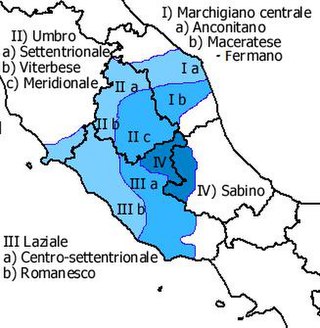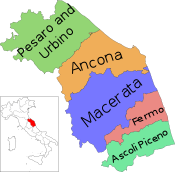Central Marchigiano dialect
This article needs additional citations for verification. (November 2008) |
| Marchigiano | |
|---|---|
| Marchigià | |
| Native to | Italy |
| Region | central Marche (provinces of Ancona, Macerata and Fermo) |
Native speakers | 900,000[citation needed] |
| Language codes | |
| ISO 639-3 | – |
ita-cen | |
| Glottolog | None |
| Linguasphere | 51-AAA-okl & 51-AAA-rba |
 | |
Marchigiano refers to a tight cluster of local Romance speech types spoken in the central part of the region Marche, in Italy, in a zone which includes the provinces of Ancona, Macerata and Fermo. It is one of the Central Italian dialect types, and forms part of the typological continuum with Umbrian dialects and Tuscan. There are notable grammatical, lexical and idiomatic differences between Marchigiano and standard Italian language, but it is generally considered, along with the rest of Central Italian dialects, rather intelligible for a speaker of Standard Italian.
In itself Marchigiano is not uniform from town to town, being divided in two main areas:
- The dialect of Ancona (Anconitano), to which the dialects of Osimo, Jesi and Fabriano also belong;
- The dialect of Macerata and Fermo (Fermano-Maceratese), with the inclusion of the variety of the area of Camerino.
Common features
The three areas of the Marchigiano dialect are united by some common features which distinguish the dialect from the others central Italian languages :
- The Italian words stressed on the penultimate syllable which end in no ni or ne undergoes apocope in the last syllable. So the word contadino (farmer) becomes contadì, the word piccioni (pigeons) becomes picciò, the word cane (dog) becomes cà.[1]
- The Italian words which end in -aio change their last syllable in -aro. So the word fornaio (baker) becomes fornaro.[1]
- The sound [ʎ] (gli) of the Italian words is changed to a simple [i]. So the word figlio [ˈfiʎːo] (son) becomes fìio or fio [ˈfio].
- Generally the final sound -o of the Italian words is changed to -u : fornaio (baker) > fornaru, figlio (son) > fiiu.
- The infinitive of the Italian verbs loses the final sound -re : amare (to love) > amà, mettere (to put) > mette, morire (to die) > morì.[2]
- The group ng undergoes assimilation to gn : mangiamo (we eat) > mangamo.[2]
- The third-person plural inflection is the same of the singular one. So the word ama can mean he (she, it) loves or they love.[2]
The conjugation of to be and to have got at the present indicative tense in the two main dialects is as follows :
| English | Anconitano | Maceratese | Italian | |
|---|---|---|---|---|
| I | am | so | so | sono |
| you | are | sei | ssi | sei |
| he/she/it | is | è | adè | è |
| we | are | semo | simo | siamo |
| you | are | sé | sete | siete |
| they | are | è(ne) | adè | sono |
| English | Anconitano | Maceratese | Italian | |
|---|---|---|---|---|
| I | have got | ciò | ciò | ho |
| you | have got | ciài | ci(ài) | hai |
| he/she/it | has got | cià | cià | ha |
| we | have got | ciavémo | ciaìmo | abbiamo |
| you | have got | ciavé | ciaéte | avete |
| they | have got | cià(ne) | cià | hanno |
Features of the three areas
Ancona's dialect
The dialect of Ancona is spoken in the region of the town of Ancona, Porto Recanati, Loreto, Osimo, Jesi, Chiaravalle and Falconara. Particularly this dialect's speakers always use the articles el (the male singular, Italian il) unlike standard Italian which in some cases uses lo (the male singular). Only the speakers of the towns which are closer to Macerata (Osimo, Castelfidardo, Loreto, Porto Recanati) use the article lo as in Italian.[1] These cities also undergo other influences from Macerata's dialect because they are closer to it.[1]
Fabriano's dialect
The dialect of Fabriano is spoken in the town of Fabriano (closer to Umbria) and in the towns closer to it. Rhotacism occurs in this dialect (calza (sock) > carza, fulmine (lightning) > furmine).
Macerata's dialect
The dialect of Macerata is spoken in the province of Macerata and in the Fermo's one. The speakers of Macerata,to say the, use lu (male singular) and lo (neuter singular) . Rhotacism occurs. A lot of assimilations occur:
- nd > nn : mettendo (putting) > mettenno,
- mb > mm : gamba (leg) > gamma,
- nt > nd : pianta (plant) > pianda,
- mp > mb : campo (field) > cambu,
- ld > ll : caldo (hot) > callu.
Vocabulary
This section possibly contains original research. (September 2014) |
There follows a list of nouns, verbs and other words from Marchigiano :
- ammò (adv. by this time; now),
- babbu (n. dad; father),
- bardasciu or vardasciu (n. boy; child),
- bedollu or bidullu (n. poplar),
- brenciu or vrenciu (adj. bitter; sour),
- ciambottu or ciammottu (n. toad / clumsy),
- cuscì (adv. in this way),
- grannola (n. hail),
- (a)lluccà (vb. to shout; to scream),
- nnertu (adj. thick),
- rosciu or rusciu (adj. red),
- sbisgià or sbiscià (vb. to slide),
- scì (adv. yes).

